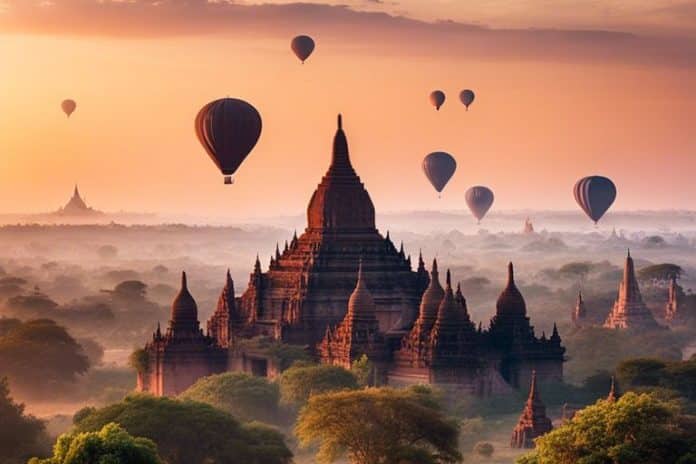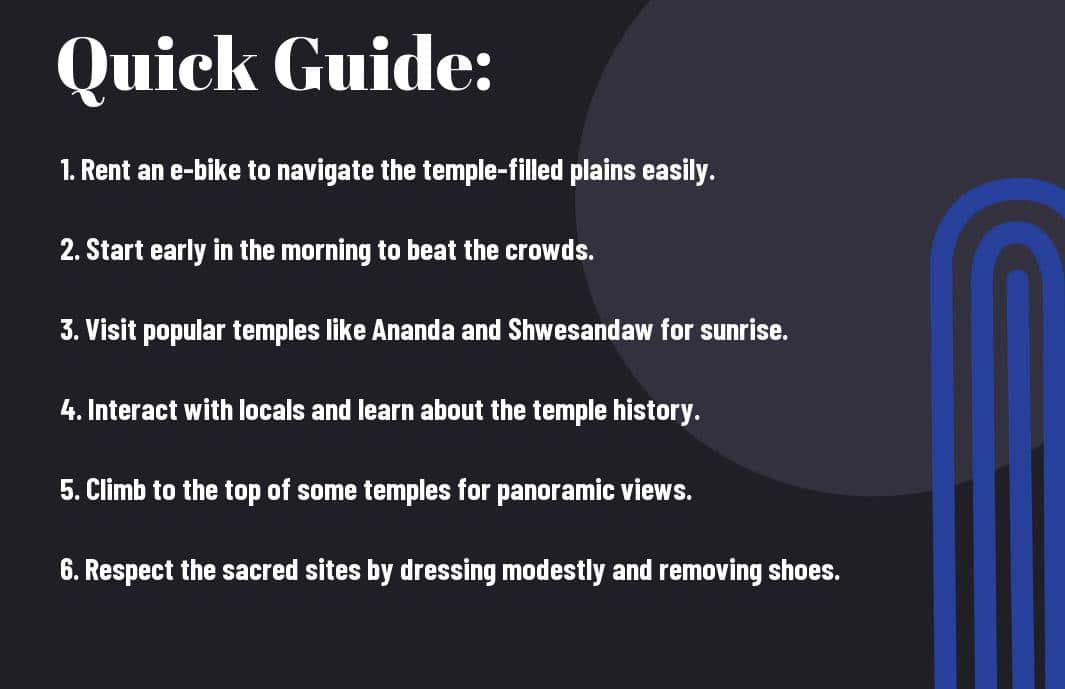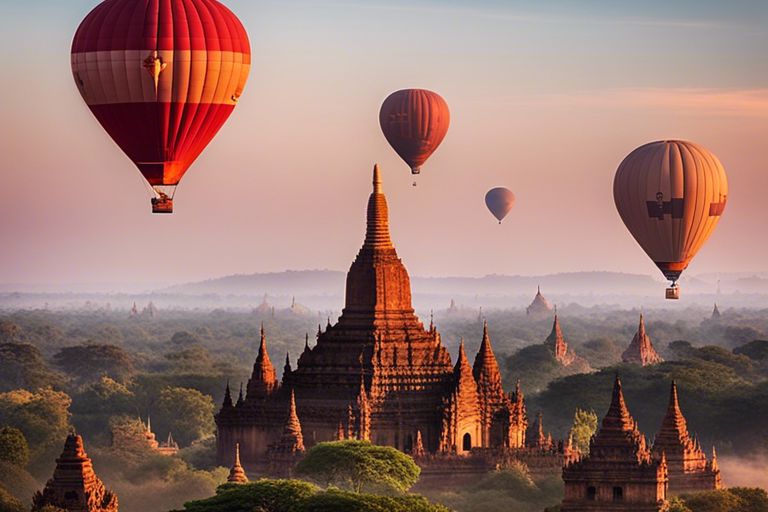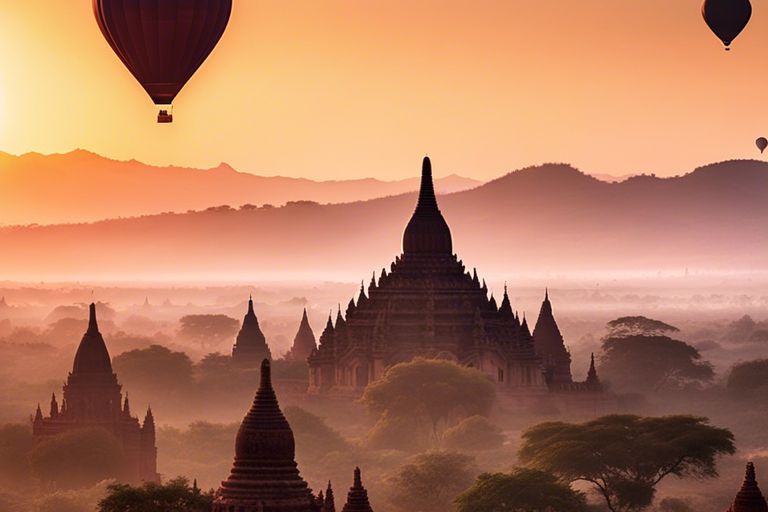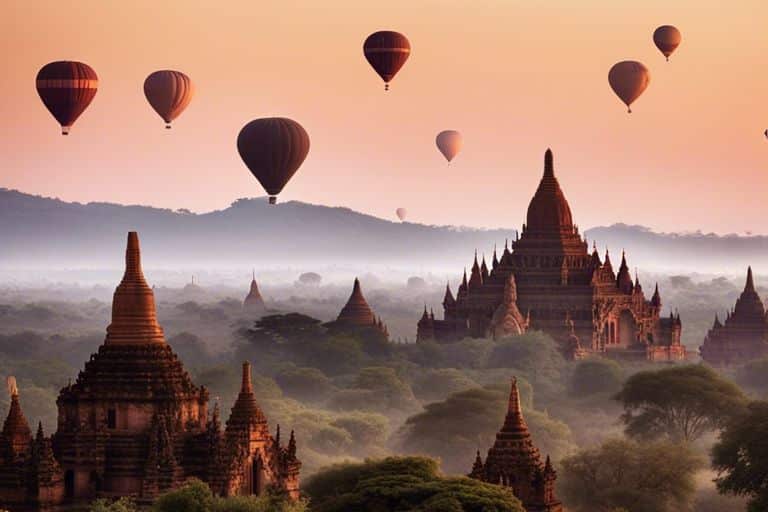You’ve decided to launch on a journey to one of the most majestic and awe-inspiring places on earth – the temples of Bagan in Myanmar. With over 2,000 ancient temples scattered across the plains, Bagan is a playground for history enthusiasts, culture lovers, and adventurers alike. However, exploring these iconic religious sites requires careful planning and a sense of adventure.
Before you set out to explore the temples of Bagan, it’s crucial to respect the local customs and traditions. Dress modestly, remove your shoes before entering the temples, and be mindful of your actions to preserve the sanctity of these sacred sites. Additionally, be prepared for extreme weather conditions – the region can get scorching hot during the day and chilly at night, so pack accordingly. Remember to carry enough water, sunscreen, and hats to protect yourself from the sun.
As you navigate through the labyrinth of temples, make sure to watch your step as some staircases can be steep and uneven. Take your time to soak in the magnificent architecture and intricate carvings that adorn these structures. Lastly, don’t forget to catch a breathtaking sunrise or sunset over the plains of Bagan – a sight that will stay with you long after your journey ends.
Key Takeaways:
- Bagan is home to over 2200 temples and pagodas, making it a must-visit destination for history and architecture enthusiasts.
- The best way to explore the temples of Bagan is by renting an e-bike or a bicycle, allowing you the flexibility to visit multiple sites in a day.
- Be sure to catch a sunrise or sunset from one of the temples for breathtaking panoramic views of the Bagan plains.
- Respect the local customs by dressing modestly when visiting the temples, covering your shoulders and knees.
- Take your time to explore the less crowded temples, as they often hold hidden gems and offer a more serene experience.
- Interact with locals and learn about the history and stories behind the temples to gain a deeper understanding and appreciation of the culture.
- Don’t miss out on visiting some of the renowned temples like Ananda Temple, Shwezigon Pagoda, and Dhammayangyi Temple for their unique architecture and historical significance.
Understanding Bagan
There’s something truly magical about Bagan, the ancient city located in the Mandalay Region of Myanmar. This archaeological zone is famous for its stunning temples and pagodas, which offer a glimpse into the rich history and spirituality of the region. As you wander through the plains of Bagan, you can’t help but feel the weight of centuries of history bearing down on you.
Historical Context of the Bagan Temples
Bagan, formerly known as Pagan, was the capital of the Pagan Kingdom from the 9th to the 13th centuries. During this time, over 10,000 Buddhist temples, pagodas, and monasteries were constructed in the Bagan plains, making it one of the most impressive religious sites in the world. The city was a center of Buddhist scholarship and learning, attracting monks and scholars from all over Asia.
The Bagan Kingdom eventually fell in the late 13th century due to invasions and natural disasters, leading to the decline of the city. Many of the temples were damaged over the years, but a significant number still stand today, offering visitors a glimpse into the city’s glorious past.
Architectural Styles and Influences
With influences from Indian, Mon, and Pyu architectural styles, the temples of Bagan showcase a unique blend of design elements that set them apart from other Southeast Asian structures. The temples range in size from small, simple shrines to large, ornate structures with intricate carvings and Buddha images. The use of brick and stucco in construction is a notable feature of Bagan architecture, giving the temples their distinctive red hue.
To truly appreciate the architectural diversity of Bagan, take a closer look at temples like Ananda, Dhammayangyi, and Shwezigon, each representing a different period and style of construction. The meticulous craftsmanship and attention to detail in these structures are a testament to the skill and dedication of the artisans who built them.
The Spiritual Significance of the Sites
If you’re looking to research deeper into the spiritual significance of the Bagan temples, you’ll be fascinated by the rituals and practices that have been preserved for centuries. The temples are not just architectural marvels but also sacred spaces where locals and pilgrims come to pay their respects, offer prayers, and participate in religious ceremonies. The tranquil atmosphere of these sites is palpable, inviting you to connect with something greater than yourself.
For instance, at sunrise or sunset, watching the sun cast its golden hues over the temple tops can be a truly spiritual experience, evoking a sense of awe and wonder at the beauty of the world. Many visitors choose to participate in meditation or yoga sessions within the temple grounds, seeking inner peace and enlightenment in this sacred space.
Types of Temples in Bagan
After exploring the vast expanse of temples in Bagan, it becomes apparent that these ancient structures can be categorized into different types based on their architectural styles and purposes. Understanding the various types of temples in Bagan can enrich your experience and provide a deeper insight into the history and culture of this fascinating region. Let’s research into the different categories of temples that you will encounter in Bagan.
| 1. Stupas | 4. Monasteries |
| 2. Temples | 5. Shrines |
| 3. Pagodas |
Exploring Stupas: Significance and Examples
There’s a significant presence of stupas in Bagan, with each stupa holding historical and religious significance. Stupas are dome-shaped structures that contain relics and are used as a place of meditation and worship. Some notable examples of stupas in Bagan include the Shwezigon Pagoda, which is considered one of the holiest sites in Myanmar, and the Mingalazedi Pagoda, known for its stunning panoramic views of the Bagan plains.
Stupas in Bagan often feature intricate architectural details such as ornate carvings and elaborate stupas that date back to ancient times. These structures serve as a testament to the rich cultural heritage of Myanmar and provide visitors with a glimpse into the spiritual practices of the region. Exploring the stupas in Bagan is not only a visual delight but also a journey through history and tradition.
This category of temples is crucial for understanding the religious and architectural landscape of Bagan. By visiting and learning about the significance of stupas, visitors can gain a deeper appreciation for the cultural tapestry that defines this ancient city. This knowledge enhances the overall temple exploration experience and offers a profound connection to the spiritual essence of Bagan.
Distinguishing Temples and Pagodas
There’s an important distinction between temples and pagodas in Bagan that is crucial for visitors to understand. Temples are structures used for Buddhist meditation and worship, often containing Buddha images and relics. On the other hand, pagodas are typically solid structures that house relics, and their main function is to enshrine a sacred object.
An understanding of the difference between temples and pagodas allows visitors to appreciate the diversity of architectural styles and religious practices in Bagan. While temples offer a sanctuary for meditation and prayer, pagodas serve as symbolic representations of Buddhist teachings and principles. This distinction adds depth to the temple exploration experience and provides insights into the cultural significance of each structure.
Stupas, temples, and pagodas collectively form the architectural ensemble that defines the landscape of Bagan. Each type of structure contributes to the religious and cultural fabric of the region, showcasing the intricate craftsmanship and spiritual devotion of the people who built them. By distinguishing between these different types of temples, visitors can gain a more nuanced understanding of the historical and religious significance of Bagan’s architectural wonders.
Lesser-Known Temples Worth Visiting
Assuming a less-visited path in Bagan can lead you to hidden gems that are lesser-known but equally captivating. These temples offer a more intimate and tranquil experience, away from the crowds that flock to the popular sites. Exploring these hidden gems allows you to appreciate the beauty and serenity of Bagan in a more contemplative setting.
To truly immerse yourself in the spiritual and historical ambiance of Bagan, consider venturing off the beaten path to discover these hidden treasures. While the popular temples are undoubtedly awe-inspiring, the lesser-known temples have a unique charm and mystique that can enrich your journey through this ancient city. Don’t miss the opportunity to explore these hidden gems and uncover the secrets they hold.
Preparing for Your Trip
Best Time to Visit Bagan
The best time to visit Bagan and explore its stunning temples is during the dry season, which typically runs from November to February. During this time, you can expect pleasant temperatures, clear skies, and minimal rainfall, making it ideal for outdoor activities. However, this is also the peak tourist season, so be prepared for larger crowds and higher prices. If you prefer to avoid the crowds, consider visiting during the shoulder seasons of March to May or September to October, but be prepared for hotter temperatures and occasional rain showers.
Essential Packing List for Temple Exploration
You should pack light and comfortable clothing, as you’ll be doing a lot of walking and exploring in Bagan. Essentials for temple exploration include sunscreen, a hat, sunglasses, comfortable shoes, and a reusable water bottle. It’s also a good idea to carry a light scarf or shawl to cover your shoulders when visiting temples, as a sign of respect.
Additionally, don’t forget to bring a camera or smartphone to capture the beauty of the temples, and a power bank to keep your devices charged throughout the day. A small backpack is handy for carrying all your vitals while keeping your hands free to climb stairs and navigate through temple ruins.
Lastly, it’s vital to carry some cash with you, as not all places in Bagan accept credit cards. Be sure to have some local currency (Kyat) on hand for entrance fees, souvenirs, and tipping local guides or vendors.
Travel and Accommodation Tips
When traveling to Bagan, it’s vital to book your accommodation in advance, especially during the peak season, to secure the best options at reasonable prices. There are a variety of accommodations available in Bagan, ranging from luxury resorts to budget guesthouses, so you can choose one that fits your preferences and budget.
For getting around Bagan and exploring its temples, you can rent a bicycle, e-bike, or hire a local taxi. Keep in mind that some of the temple areas are off-limits to vehicles, so having a mode of transportation that allows you to walk or cycle to these sites is vital for a comprehensive exploration of Bagan.
Regarding dining, Bagan offers a variety of local restaurants and street food vendors where you can sample traditional Burmese dishes. Remember to drink only bottled water to avoid getting sick during your trip, and be cautious with food hygiene to ensure a healthy and enjoyable experience in Bagan.
To explore deeper into the local culture, consider participating in a traditional cooking class or visiting a local market to interact with the friendly locals and learn about their way of life. Thou should always respect the customs and traditions of the local people to make the most of your travel experience in Bagan.
More on Travel and Accommodation Tips
To ensure a smooth travel experience in Bagan, it’s recommended to carry a copy of your passport and travel insurance details with you at all times. This will help in case of any emergencies or unforeseen situations during your trip.
- Research and plan your temple visits ahead of time to maximize your time in Bagan and prioritize the must-see temples such as Shwezigon Pagoda, Ananda Temple, and Dhammayangyi Temple.
- When exploring temples, watch your step and be mindful of your surroundings to avoid tripping hazards or damaging the ancient structures. Thou should never climb on temple ruins or touch sacred artifacts.
Travel responsibly, respect the local culture, and immerse yourself in the rich history and spirituality of Bagan for a truly memorable travel experience.
Step-By-Step Guide to Exploring Bagan
Once again, if you’re planning a trip to Bagan, Myanmar, you’ll want to get your hands on a comprehensive guide to make the most of your visit. Check out The Backpackers Travel Guide To Bagan, Myanmar for detailed insights and tips. Below is a breakdown of how to explore the temples of Bagan effectively:
| Starting Your Journey: Arrival and Orientation | Temple Hopping: A Daily Itinerary |
| The process of arriving in Bagan can be overwhelming with so much to explore. Take time to orient yourself with a map of the area and understand the layout of the temples. | When planning your daily temple visits, prioritize the key temples such as Shwezigon Pagoda, Ananda Temple, and Sulamani Temple for their historical and architectural significance. |
Starting Your Journey: Arrival and Orientation
The journey to Bagan typically begins at Nyaung U Airport, where you’ll find several transportation options to reach the temple region. Once you arrive, it’s crucial to secure accommodation in advance due to the high number of visitors. Familiarize yourself with the locations of the major temples, as Bagan spans over a vast area with thousands of temples scattered throughout the plains. Consult with locals or tour guides for the best way to navigate the temples efficiently.
Temple Hopping: A Daily Itinerary
Guide your exploration by dividing Bagan into different zones and dedicating each day to a specific area. Start early in the morning to catch the sunrise from a temple rooftop, offering breathtaking views of the sunrise over the ancient city. As you venture through the temples, immerse yourself in the rich history and intricate details of each structure. Be prepared for extensive walking or cycling between temples, as some of the best-hidden gems are tucked away from the main roads.
Daily Temple Hopping: Begin your day with a visit to the majestic Dhammayangyi Temple, known for its massive size and unique brickwork. Continue to the serene Mahabodhi Temple, inspired by the Bodh Gaya in India, and end your day at the picturesque Bupaya Pagoda, set along the Irrawaddy River. Each temple offers a distinct experience, showcasing the diverse architectural styles and religious influences present in Bagan.
Off the Beaten Path: Discovering Hidden Gems
Little-known temples and ruins lie off the main tourist trail, waiting to be explored by intrepid travelers. Beyond the popular landmarks, venture into the lesser-visited areas to uncover ancient frescoes, hidden courtyards, and mystical atmospheres. While some temples may require a bit of climbing or navigating through narrow passages, the reward of discovering secluded relics is unparalleled.
Temple: For a unique experience, seek out the hidden gem of Lemyethna Temple, which offers panoramic views of the surrounding temples and countryside. Alternatively, explore the ruins of Nandamanya Temple, where you can witness the intricate carvings and peaceful ambiance away from the crowds. By delving into these offbeat locations, you’ll gain a deeper appreciation for the cultural heritage and spiritual aura that permeates the temples of Bagan.
Factors to Consider When Exploring
For a fulfilling and respectful exploration of the temples in Bagan, Myanmar, there are several key factors to consider.
- Cultural Sensitivities and Respectful Behavior
It is important to be mindful of the local customs and traditions when visiting these sacred sites. Respect the signs of reverence shown by the locals and follow their lead when entering the temples. Remember to dress modestly, remove your shoes before entering any religious sites, and avoid climbing on the ancient structures.
Cultural Sensitivities and Respectful Behavior
Cultural sensitivity plays a crucial role in ensuring a positive experience while exploring Bagan. Remember that these temples hold immense spiritual and historical significance for the locals. Avoid disrupting any religious ceremonies or rituals taking place within the temples. Be mindful of taking photos, especially around worshippers, and always ask for permission before photographing individuals.
Respectful behavior towards the local community is paramount. Engage with the locals respectfully, learn about their traditions, and be considerate of their way of life. By showing respect and understanding towards the people and their culture, you can truly appreciate the beauty and significance of Bagan’s temples.
Any disrespectful behavior towards the local customs or traditions can not only be offensive but may also result in being asked to leave the temples. Remember that you are a guest in this sacred space and should conduct yourself accordingly.
Navigating Bagan’s Climate and Terrain
One of the key elements to consider when exploring Bagan is the region’s climate and terrain. The hot and arid climate of Bagan can be challenging, especially during the peak summer months. It is advisable to carry an adequate supply of water, wear sunscreen, and dress in breathable clothing to avoid heat exhaustion.
Respectful Timing Your Visits for Optimal Experience
On a more positive note, visiting Bagan during the early morning or late afternoon offers not only cooler temperatures but also stunning sunrise and sunset views over the temples. Witnessing the sun casting its golden light over the ancient pagodas is a truly magical experience. Additionally, fewer crowds during these times allow for a more peaceful and intimate exploration of the temples.
Travel Tips for the Bagan Temples
Unlike other popular tourist destinations, exploring the temples of Bagan in Myanmar comes with its own unique set of challenges and considerations. To ensure a safe and enjoyable visit, here are some crucial travel tips to keep in mind:
- Safety and Security: Ensure you take necessary precautions while exploring the temples. Beware of uneven steps, low doorways, and precarious paths. Carry a first aid kit and stay hydrated in the hot weather. Avoid venturing into isolated areas alone.
- Understanding Local Etiquette and Customs: Respect the local customs and traditions of Myanmar. Dress modestly when visiting temples and religious sites. Remove your shoes before entering pagodas and show reverence to sacred objects.
- Health Considerations and Precautions: Be mindful of your health during your visit to Bagan. Protect yourself from the harsh sun by wearing sunscreen and a hat. Stay hydrated and avoid drinking tap water. Be cautious of street food vendors to prevent food-borne illnesses.
Safety and Security While Exploring
Even though Bagan is a relatively safe destination, it is crucial to be cautious while exploring the temples. Watch your step on the ancient staircases and be mindful of your surroundings. Keep your belongings secure to avoid theft, and consider using a money belt or neck pouch for extra security. After a long day of temple-hopping, it is always wise to return to your accommodation before dark.
Understanding Local Etiquette and Customs
Etiquette plays a significant role in Myanmar, and visitors are expected to adhere to certain customs while exploring the temples of Bagan. Remember to dress modestly, covering your shoulders and knees, to show respect to the local culture. When interacting with locals, greet them with a respectful ‘Mingalabar’ and be mindful of your actions in sacred spaces. Taking photographs of monks or Buddha images may be considered disrespectful, so always ask for permission first.
Bagan’s temples hold deep cultural and religious significance for the people of Myanmar. Visitors should be mindful of their behavior and show reverence to the sites they are exploring. While it is a place of wonder and beauty, it is crucial to approach your visit with sensitivity and respect.
Health Considerations and Precautions
The hot and humid climate in Bagan can take a toll on your health if you are not adequately prepared. The intense sun can lead to sunburn and dehydration, so be sure to drink plenty of water and reapply sunscreen regularly. Plus, insect repellent is crucial to protect yourself from mosquito-borne diseases like dengue fever and malaria. Be cautious while climbing steep stairs in the temples to avoid accidents.
Understanding the potential health risks and taking necessary precautions can ensure a smooth and enjoyable visit to the temples of Bagan. By prioritizing your well-being and being aware of your surroundings, you can make the most of your time exploring this fascinating archaeological site.
The Pros and Cons of Different Touring Options
Independent Exploration vs. Guided Tours
With independent exploration, travelers have the freedom to create their own itinerary, wander at their own pace, and discover hidden gems off the beaten path. This option allows for flexibility in scheduling and the ability to immerse oneself in the local culture. On the other hand, guided tours provide valuable insights from knowledgeable guides, access to insider information, and the convenience of having logistics taken care of. However, some may find guided tours restricting and prefer the adventure of exploring on their own.
| Pros | Cons |
| Flexibility in itinerary | Restricting |
| Immersion in local culture | Lack of personal exploration |
| Freedom to wander at own pace | Scheduling logistics |
The Scooter Experience: Freedom and Caution
Cons
With the scooter experience, travelers can enjoy the freedom of exploring Bagan at their own pace, stopping whenever and wherever they please to admire the temples. However, it is important to exercise caution as the roads may be uneven and traffic rules may differ from what one is accustomed to. Renting a scooter also requires a certain level of skill and confidence in navigating unfamiliar routes.
Exploring Bagan on a scooter can be an exhilarating experience, providing a sense of adventure and the thrill of discovering hidden spots off the main tourist trails. However, travelers should be mindful of safety precautions, such as wearing helmets, following local traffic regulations, and being aware of the surroundings to avoid any potential risks.
| Freedom of exploration | Need for caution |
| Flexibility in stopping | Uneven roads |
| Thrill of discovery | Skilled navigation required |
To explore Bagan from a different perspective, travelers can opt for the balloon option, which provides a luxurious and scenic way to admire the temples from above. Tours
Embarking on a balloon tour offers a unique and breathtaking view of the ancient city, allowing travelers to witness the sunrise or sunset casting a magical glow over the temples. The experience is unparalleled in terms of serenity and grandeur, providing a memorable way to appreciate the beauty of Bagan from a bird’s eye view.
Capturing Bagan: Photography Tips
Your journey to Bagan, Myanmar, is incomplete without capturing the beauty and mystique of its ancient temples through your lens. To ensure you bring back stunning photographs that do justice to this remarkable destination, follow these photography tips:
Best Spots for Temple Photography
You have a plethora of options when it comes to choosing the perfect backdrop for your temple shots in Bagan. Some must-visit spots include the iconic Shwesandaw Pagoda, which offers panoramic views of the temples at sunrise and sunset, the lesser-known Bulethi temple with its intricate carvings, and the mystical Sulamani temple that shines brightly during the golden hour.
Sunrise and Sunset: Capturing Bagan’s Magic Moments
For those magical moments when the sun paints the sky in hues of orange and pink, head to the Bagan Viewing Tower for a bird’s eye view of the temples as the day begins or ends. Make sure to pack a sturdy tripod to capture the changing light conditions and create stunning long exposure shots of the temples against the sky.
Watching the sunrise and sunset in Bagan is a spiritually uplifting experience that will stay with you long after you leave. To truly immerse yourself in the magic of these moments, consider taking a hot air balloon ride over the temples at dawn or dusk for a breathtaking aerial perspective that will leave you in awe of Bagan’s beauty.
Responsible Photography: Respecting the Sacred Sites
When photographing the temples of Bagan, it’s important to remember that these sites are not just picturesque backdrops, but sacred places of worship for the local community. Always ask for permission before taking portraits of monks or locals, respect any signs indicating no photography zones, and avoid climbing on the temples or touching any religious artifacts to preserve their sanctity.
Embracing the Full Bagan Experience
Sampling Local Cuisine: A Culinary Adventure
Not exploring the temples of Bagan just stops at admiring ancient structures; it also involves immersing yourself in the local culinary scene. Some of the must-try dishes include the flavorful Mohinga, a traditional breakfast noodle soup, and the savory Shan-style tofu. Wander through bustling markets or dine at family-run eateries to experience the rich flavors and aromatic spices that define Burmese cuisine.
Participating in Local Festivals and Events
There’s more to Bagan than just temples; immersing yourself in local festivals and events will provide you with a deeper understanding of the culture and traditions of the region. Witness the vibrant celebrations of Thingyan, the Burmese New Year water festival, where locals engage in water fights and traditional performances. Take part in pagoda festivals, such as Ananda Pagoda Festival, to experience the spiritual essence and lively atmosphere that characterizes these gatherings.
Bagan hosts numerous festivals throughout the year, each offering a unique insight into the local way of life. From religious ceremonies to traditional dances, these events showcase the cultural vibrancy of the region. Don’t miss the opportunity to witness and engage with the community during these festive occasions, creating lasting memories of your visit to Bagan.
Sustainable Travel: Supporting the Local Community
When visiting Bagan, it’s imperative to experience sustainable travel by supporting the local community. Engage in responsible tourism practices by choosing accommodations and tour operators that prioritize environmental conservation and the well-being of the residents. By participating in community-driven activities such as village tours or local artisan workshops, you contribute to empowering the local economy and preserving the cultural heritage of Bagan.
It is crucial to be mindful of your actions as a traveler and make conscious choices that benefit the community. By supporting local businesses and respecting the customs and traditions of the residents, you not only enhance your travel experience but also leave a positive impact on the destination for future generations to enjoy.
Summing up
Upon reflecting on the exploration of the temples of Bagan, Myanmar, it becomes clear that this ancient city is undoubtedly one of the top travel destinations in the world. The sheer magnitude of over 2,000 temples spread across the landscape offers a unique and awe-inspiring experience for visitors. Navigating this historical site requires careful planning and time management, but the reward of witnessing the stunning sunrise and sunset views amidst the ancient structures is truly one-of-a-kind.
For those looking to immerse themselves in the rich history and culture of Bagan, there are a multitude of ways to explore the temples. Whether it’s by e-bike, hot air balloon, horse carriage, or simply on foot, each method provides a different perspective and allows for a deeper connection with the surroundings. The preservation efforts of these archaeological wonders are crucial for future generations to continue to appreciate and learn from this UNESCO World Heritage Site.
In the aggregate, the temples of Bagan, Myanmar, offer a profound travel experience that captivates and inspires all who visit. The spiritual significance, architectural marvels, and panoramic views combine to create a truly magical destination that should be on every traveler’s bucket list. By following the guidelines and tips outlined in this guide, exploring the temples of Bagan will undoubtedly leave a lasting impression and create memories that will be cherished for a lifetime.
FAQ
Q: Why should I visit the temples of Bagan, Myanmar?
A: Visiting the temples of Bagan provides a unique opportunity to immerse yourself in thousands of ancient temples spread across a stunning landscape, offering a glimpse into Myanmar’s rich history and culture.
Q: When is the best time to explore the temples of Bagan?
A: The best time to explore the temples of Bagan is during the dry season, from November to February, when the weather is pleasant and there is little to no rain, allowing for optimal temple exploration.
Q: How can I get to Bagan, Myanmar?
A: Bagan can be reached by air, bus, or boat. The most convenient way is to fly into Nyaung U Airport, which is located close to the temple area.
Q: What is the best way to get around the temples of Bagan?
A: The best way to explore the temples of Bagan is by e-bike, bicycle, or horse cart. These modes of transportation allow you to navigate the temple complex at your own pace while enjoying the scenic views.
Q: Are there any important rules or customs to be aware of when visiting the temples of Bagan?
A: When visiting the temples of Bagan, it is important to dress modestly, remove your shoes before entering temple grounds, and be respectful of the religious sites by not climbing on the temples or touching the ancient artifacts.
Q: What are some must-visit temples in Bagan?
A: Some of the must-visit temples in Bagan include Shwesandaw Pagoda for sunrise or sunset views, Ananda Temple for its architectural beauty, and Dhammayangyi Temple for its imposing structure.
Q: Are there any additional activities to do in Bagan besides temple exploration?
A: In addition to exploring the temples, visitors to Bagan can enjoy hot air balloon rides for a bird’s eye view of the temples, visit local markets to experience the vibrant culture, or take a boat trip along the Irrawaddy River.
